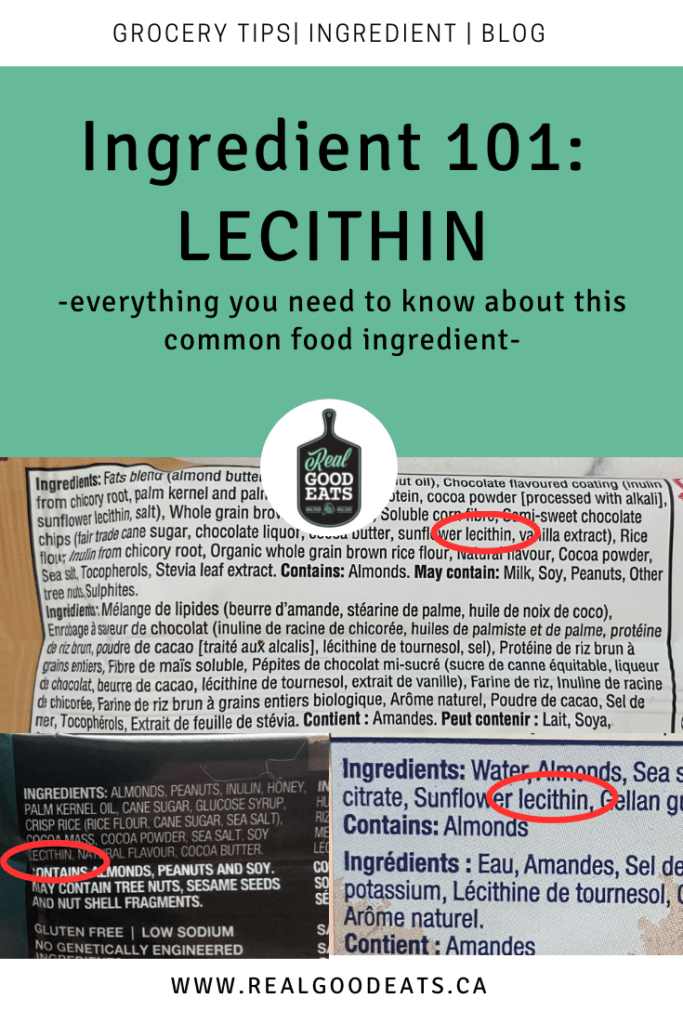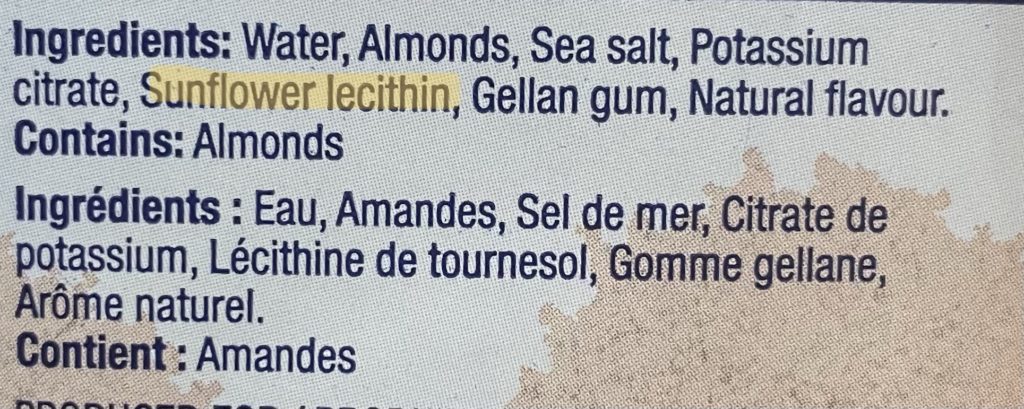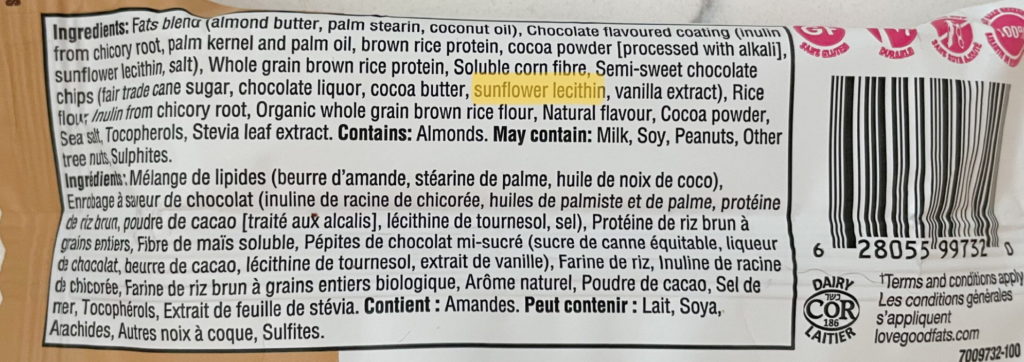If you read the ingredient list on food packages, you’ve probably come across ‘lecithin’. With so much conflicting information that exists surrounding food ingredients, it can be difficult to find unbiased, scientific information to help you make informed choices. We’re answering your questions about lecithin in this Lecithin – Food Ingredient Review to take the mystery out of this ingredient and help you grocery shop with ease.

What are Lecithins?
Lecithins were first discovered in the nineteenth century and are currently one of the most commonly used food ingredients. The term lecithin refers to a mixture of phospholipids found in plant and animal sources. Common sources of lecithin include soybeans, cotton seeds, corn, sunflower, and eggs.
The most common forms of lecithin added as ingredients to food products are soy lecithin, sunflower, and egg lecithin. Soy lecithin is the most commonly used type of lecithin in our food system because it can be economically extracted from soybean oil, and is a very stable form of lecithin.

Lecithin Food Ingredient Review
How is the ingredient lecithin made?
Three different methods are used to refine lecithin from food sources: chemical method, physical method, and enzymatic method.
In the chemical method, vegetable oil is first combined with sodium hydroxide, then the mixture is separated by centrifugation before being bleached and deoderized to result in pure lecithin. This is the most commonly used method to extract lecithin from food sources.
Physical methods may include combining the lecithin food source with citric acid, then heating and cooling the mixture to specific temperatures to yeild the lecithin.
Enzymatic methods include the enzyme phospholipase to yield lecithin, though this is less common.
Why Are Lecithins Added to Food?
Lecithins are one of the most common emulsifiers added to food products. Emulsifiers are added to products such as plant milk and salad dressing to help prevent the ingredients from separating. For example, oil and water in a salad dressing. In doing so, emulsifiers are essential in maintaining the appearance, texture, and overall stability (think: shelf life) of food products.
Lecitins may also be added to food to change the viscosity of the food item, such as chocolate, or for anti-sticking properties in sweets.

Which foods contain lecithin as an ingredient?
You’ll commonly find lecithin listed as an ingredient in baked goods, chocolate, salad dressings, non-dairy beverages, infant formulas, margarine, snack/protein bars, and crackers.
Is lecithin considered safe as a food ingredient?
Lecithin is regulated as a food ingredient in Canada and the US. It is generally recognized as safe for use by the FDA and Health Canada without limitations other than Good Manufacturing Practices. In other words, the amount of lecithin that can be added as an ingredient to foods is unrestricted.
However, there are some exceptions. A maximum amount of lecithin has been established for infant formula, margarine, cheese spreads, and ice cream. In these cases, lecithin content cannot exceed 0.2-0.75%, depending on the product category.

Lecithin Food Ingredient Review
Do Lecithins Contain Hexane?
In our research, we came across a number of websites expressing concern over the use of hexane in the production of lecithin. Here’s what we know:
Hexane is a chemical used as a solvent for extraction of vegetable oils from various seeds and crops. Hexane use in the food industry is regulated by Health Canada. The amount of hexane residue allowed for vegetable fats, seeds, and oils is 10 ppm (parts per million).
The main way that hexane will enter our diet is through processed vegetable oils. Since lecithin is a byproduct of vegetable oil, it may contain traces of hexane. It’s difficult to assess the amount of hexane present in processed food products, as different processing methods, such as those used to extract lecithin, can break down hexane.
Why does this matter? There is some concern that high levels of exposure to hexane may cause toxicity and negative effects on health. However, it’s imprtant to remember that our overall exposure to hexane in a typical diet is very low.
Our population’s estimated intake of Hexane from vegetable oils is estimated at 0.70g/kg body weight per day. To put this into perspective, an amount of 189mg/kg body weight per day of hexane is needed to cause harm.
So, TL;DR: while significant exposure to hexane is concerning, the amount of hexane found in vegetable oils is very low, and the amount found in food products with lecithin as an ingredient is likely even lower.
Are there any Health Benefits of Lecithin?
Lecithin has been studied for it’s potential benefits related to heart health, breastfeeding, digestion, and dementia. However, it is important to note that these studies utilize lecithin in supplement form and not in food sources. Our daily intake of lecithin from food sources is likely much lower than what has been studied in supplement form. For this reason, we won’t go into detail on health-related research in this post.

Is lecithin as a food ingredient good or bad for you?
We always recommend using whole (less processed) food options more often, but if you see lecithin on the ingredient list of your favourite protein bar, no need to worry. Lecithins are naturally present in some foods and play an important role as an ingredient in processed foods. Lecithins are recognized as safe by Health Canada and the FDA, and the amount typically found in food products is very low.
Lecithin Food Ingredient Review
Frequently Asked Questions
Are Soy and Sunflower Lecithin Gluten-Free?
Yes, both soy and sunflower lecithin are gluten-free. However, due to the potential risk of cross-contamination during processing, always check the label for allergens before consuming a food item.
Is soy lecithin safe for individuals with a soy allergy?
Soy lecithin is usually present in small amounts in foods and typically does not contain enough of the protein in soy to cause an allergic reaction. Because of this, soy lecithin is considered low-risk for individuals with an allergy. However, it is not 100% protein-free. Always consult your allergist before consuming any food products made with soy lecithin.
Are Soy and Sunflower Lecithin Vegan?
Yes, both soy and sunflower lecithin are vegan.
Why is soy lecithin in everything?
Lecithins are one of the most commonly used emulsifiers added to food products. Soy lecithin is the most common type of lecithin in our food system because it can be economically extracted from soybean oil, and is very stable.
Are soy and sunflower lecithin low fodmap?
Soybeans are considered high FODMAP, in particular high in GOS (galacto-oligosaccharides) and some fructans. However, because soy lecithin as an ingredient is used in small amounts, it is likely low FODMAP. Sunflower lecithin is also thought to be low FODMAP.
Enjoyed this ingredient review? Check out our review of Natural Flavours in our post What are Natural Flavours and Should You Avoid Them?
Sources:
- Lecithins: A comprehensive review of their properties and their use in formulating microemulsions. Gutierrez-Mendex, N. et al. 2022. Journal of Food Biochemistry.
- Book: Modifying Food Texture (Volume 1: Novel Ingredients and Processing Techniques). 2015.
- Book: Food Emulsifiers and their Applications. 2019. Hasenhuettl, Gereard L.
- Screening Assessment for the Challenge Hexane. Environment Canada (2009)
- Soy – A Priority Allergen. Government of Canada (2016, August 31). Canada.ca.
- List of Permitted Emulsifying, Gelling, Stabilizing, Thickening Agents. Canada, H. (2022, June 3). Government of Canada. Canada.ca.

